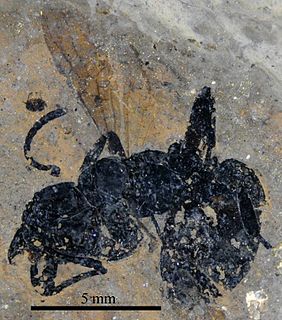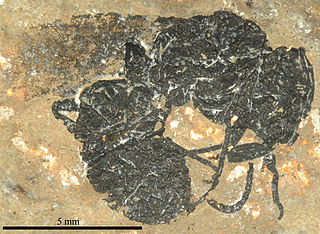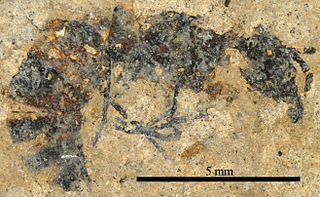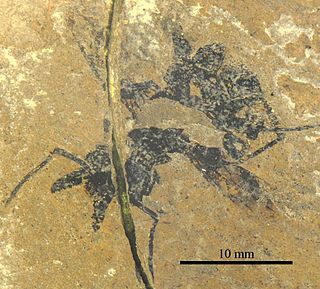In ants, the traditional subfamily Ponerinae has been subdivided into several Poneromorph subfamilies, with several former tribes now elevated to subfamily rank. [1] According to this analysis, some ponerine groups may be more closely related to other subfamilies than to each other. The subfamilies of "poneromorph" Formicidae include:
In biological classification, a subfamily is an auxiliary (intermediate) taxonomic rank, next below family but more inclusive than genus. Standard nomenclature rules end subfamily botanical names with "-oideae", and zoological names with "-inae".

Ponerinae is a subfamily of ants in the Poneromorph subfamilies group, with about 1,600 species in 47 extant genera, including Dinoponera gigantea - one of the world's largest species of ant. Mated workers have replaced the queen as the functional egg-layers in several species of ponerine ants. In such queenless species, the reproductive status of workers can only be determined through ovarian dissections.
In anthropology, a tribe is a human social group. Exact definitions of what constitutes a tribe vary among anthropologists. The concept is often contrasted with other social groups concepts, such as nations, states, and forms of kinship.
- Amblyoponinae
- Ectatomminae (apparently related to the widely distributed and highly diverse Myrmicinae)
- Heteroponerinae
- Paraponerinae
- Ponerinae (in a much more restricted sense)
- Proceratiinae.
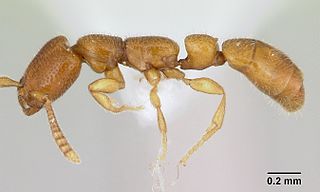
Amblyoponinae is a subfamily of ants in the poneromorph subfamilies group containing 13 extant genera and one extinct genus. The ants in this subfamily are mostly specialized subterranean predators. Adult workers pierce the integument of their larvae to imbibe haemolymph, earning them the common name Dracula ant.

Ectatomminae is a subfamily of ants in the poneromorph subfamilies group containing four extant and three extinct genera in two tribes. The subfamily was created in 2003 when Barry Bolton divided the Ponerinae subfamily into six subfamilies.

Myrmicinae is a subfamily of ants, with about 140 extant genera; their distribution is cosmopolitan. The pupae lack cocoons. Some species retain a functional sting. The petioles of Myrmicinae consist of two nodes. The nests are permanent and in soil, rotting wood, under stones, or in trees.
Long considered primitive on the basis of retention of a typical hymenopteran sting and pupae in cocoons, some groups among the poneromorphs exhibit considerable specialization in predatory habits and mandibular form.
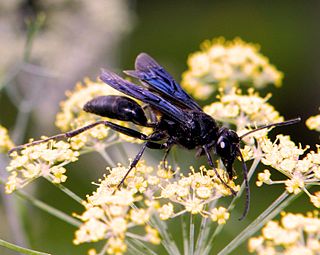
Hymenoptera is a large order of insects, comprising the sawflies, wasps, bees, and ants. Over 150,000 living species of Hymenoptera have been described, in addition to over 2,000 extinct ones.
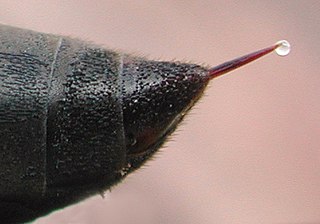
A stinger, or sting, is a sharp organ found in various animals capable of injecting venom, usually by piercing the epidermis of another animal.

A pupa is the life stage of some insects undergoing transformation between immature and mature stages. The pupal stage is found only in holometabolous insects, those that undergo a complete metamorphosis, with four life stages: egg, larva, pupa, and imago. The processes of entering and completing the pupal stage are controlled by the insect's hormones, especially juvenile hormone, prothoracicotropic hormone, and ecdysone.
These two evolutionary developments are often, but not necessarily, seen in association: elongated mandibles with modified teeth for handling large and potentially toxic prey in Amblyopone and Thaumatomyrmex , and strongly modified "snap-jaws" and associated musculature in the generalized predator Odontomachus .

Amblyopone is a genus of 9 species of ants, found in Australia, New Caledonia, New Guinea and New Zealand. Ants of this genus possess the gamergate, meaning workers are able to reproduce within a colony lacking a queen.

Thaumatomyrmex is a Neotropical genus of ants in the subfamily Ponerinae, found from Mexico to Brazil. They are notable for their pitchfork-shaped mandibles, which they use to capture millipedes of the order Polyxenida. The genus is a specialist predator of polyxenids, and one of only two ant genera known to prey upon polyxenids.

Odontomachus, or trap-jaw ants, is a genus of carnivorous ants found in the tropics and subtropics throughout the world.
Most poneromorphs are strict predators just like their ancestors (stinging Hymenoptera). Foraging for extrafloral nectar and honeydew from sap-sucking insects has secondarily evolved in Ectatomminae and Paraponerinae, as well as Odontomachus (Ponerinae). A taste for sweets (nectar, fruit) can be considered an evolutionary "advancement" among the ants.

Honeydew is a sugar-rich sticky liquid, secreted by aphids and some scale insects as they feed on plant sap. When their mouthpart penetrates the phloem, the sugary, high-pressure liquid is forced out of the anus of the aphid. Honeydew is particularly common as a secretion in hemipteran insects and is often the basis for trophobiosis. Some caterpillars of Lycaenidae butterflies and some moths also produce honeydew. Honeydew can cause sooty mold—a bane of gardeners—on many ornamental plants. It also contaminates vehicles parked beneath trees, and can then be difficult to remove from glass and bodywork. Honeydew is also secreted by certain fungi, particularly ergot.






